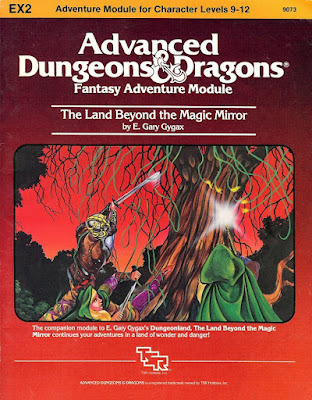Retrospective: The Land Beyond the Magic Mirror
 My reading of
White Dwarf #4
this week reminded me first of Gary Gygax's Dungeonland (which was the subject of a previous retrospective) and then of its sequel – companion? – The Land Beyond the Magic Mirror (hereafter Magic Mirror). Like Dungeonland, this module was first published in 1983, at the start of a period during which Gary Gygax was extraordinarily prolific, creating a number of very remarkable, if flawed, products for AD&D. Unlike Dungeonland, whose interior artwork was inappropriately provided by Timothy Truman, Magic Mirror is almost entirely illustrated by the late, great Jim Holloway, whose darkly humorous style is perfect for an adventure module of this sort.
My reading of
White Dwarf #4
this week reminded me first of Gary Gygax's Dungeonland (which was the subject of a previous retrospective) and then of its sequel – companion? – The Land Beyond the Magic Mirror (hereafter Magic Mirror). Like Dungeonland, this module was first published in 1983, at the start of a period during which Gary Gygax was extraordinarily prolific, creating a number of very remarkable, if flawed, products for AD&D. Unlike Dungeonland, whose interior artwork was inappropriately provided by Timothy Truman, Magic Mirror is almost entirely illustrated by the late, great Jim Holloway, whose darkly humorous style is perfect for an adventure module of this sort.Much as I love Dungeonland, I've always preferred Magic Mirror. There are a couple of reasons why this is so, starting with the aforementioned Holloway artwork. Lewis Carroll's stories of Wonderland are famously weird, filled with characters and situations that are equal parts scary and humorous. In my opinion, Holloway manages to thread the needle between these two poles in exactly the right fashion. The result is a better complementarity between word and pictures than in Dungeonland.
More important than the module's esthetics – vital though that is! – is its specific content. What specific content, you might ask? The first thing that immediately comes to mind is the wooden house of Murlynd. Murlynd is not a character from Carroll's stories but rather from the early days of Gygax's own Greyhawk campaign. A creation of Gygax's closest friend, Don Kaye, Murlynd is a magic-user but one whose adventures took him to the Old West, hence the reason that he's often depicted dressed as a cowboy, complete with firearms.
For reasons I cannot fully articulate, I've always found characters like Murlynd strangely compelling. I suppose it's the way that he represents an older understanding of fantasy, one that's not bound by the narrow definitions that we tend to accept nowadays. I've long admitted that I used to struggle with this wilder kind of fantasy. Yet, even as I was struggling with it, some part of me must have recognized that there was something liberating and, above all, fun about this approach to fantasy and Murlynd in his Stetson is fun – or so I think. Regardless, I thoroughly enjoyed Murlynd's house, filled with anachronistic items from throughout time and space, as well as a talking grandfather clock, a lightning quasi-elemental, and "the Witch-Ghost" in the attic, among other oddities.
Of course, there are other equally notable elements of the module. For example, there's the Garden of Colossal Flowers, filled with vain, silly, and rude plants with humanoid faces; the Chessboard Fields that the characters can only cross by playing a violent version of the game; all the creatures mentioned in Jabberwocky; Humpty Dumpty; and the manor house that includes the Mad Feast Hall. Like Carroll's stories, Magic Mirror is equal parts funny and dangerous, but, above all, it's weird and whimsical. I think that's what made such an impression on me when I first read it nearly four decades ago. The module taught me that I didn't need to be such a stick in the mud about fantasy. I could cut loose from time to time and lean into the wild and woolly aspect of the genre. Whether the lessons I learned truly had anything to do with The Land Beyond the Magic Mirror or not, I feel a certain gratitude toward it and to Gary Gygax for broadening my vision of fantasy.
James Maliszewski's Blog
- James Maliszewski's profile
- 3 followers



